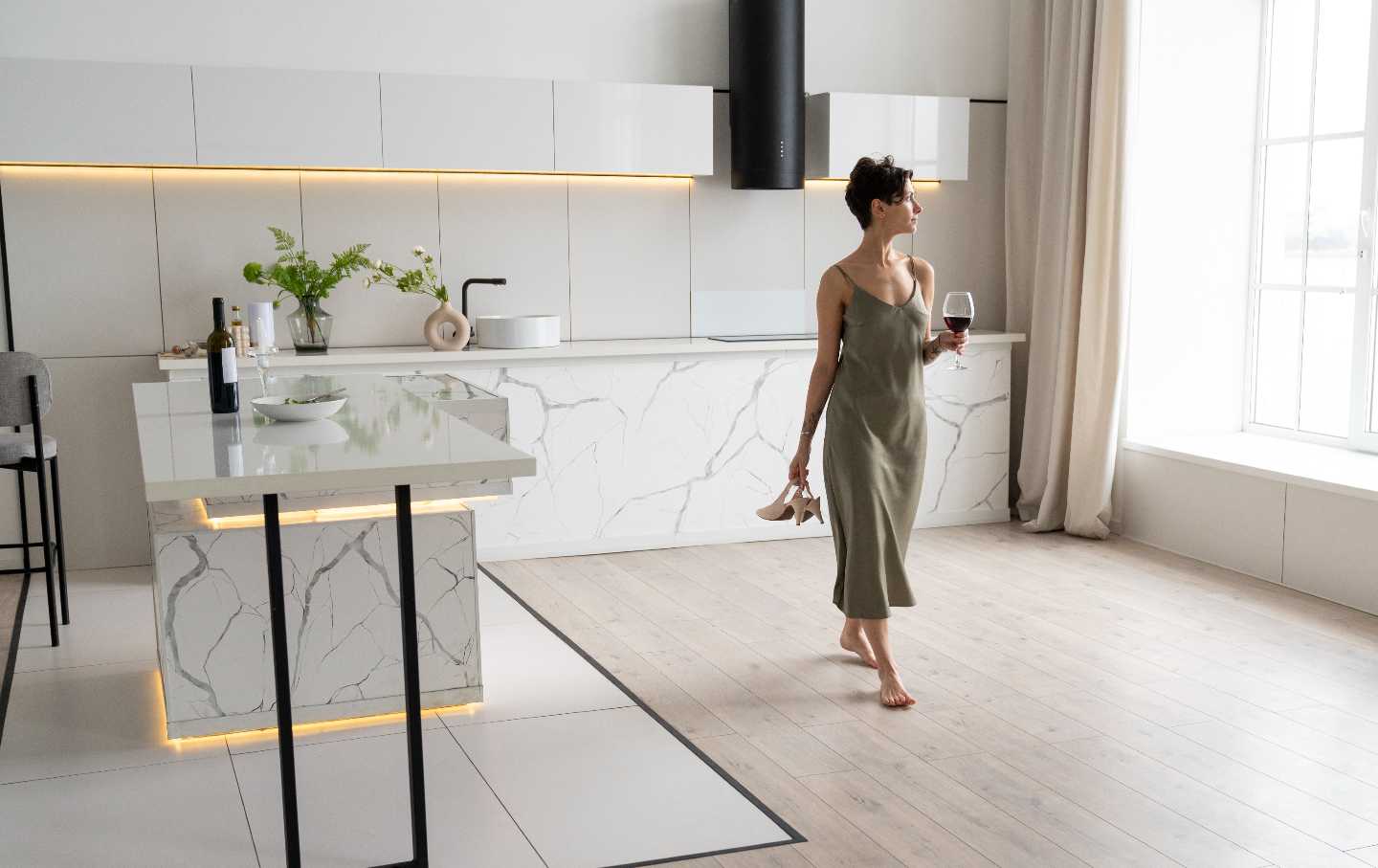Capitalist Rot Has Spread to American Kitchens
We’ve privileged constant renovation over resilience, and it’s damaged the aesthetics and functionality of domestic architecture.

I am currently living in Ljubljana, Slovenia, with two roommates in an apartment with a very small kitchen. By American standards, it’s closer to what you’d call a kitchenette. It consists of a stainless-steel sink/stove combo (with a slow, tiny dishwasher nested underneath), an IKEA storage cart, and the smallest refrigerator in existence, beneath which is an equally tiny oven. Even my old 500-square-foot studio in Washington, D.C., which featured miniature versions of most appliances, felt bigger than this. Every time I come to Europe, I experience culture shock when I first see a minuscule apartment kitchen. There are luxurious exceptions for the wealthy, of course, but in most cases the kitchen is simply not the most important room. In the United States, it’s hard to escape the sense that one’s kitchen is a status symbol that determines the quality of one’s domesticity and social life.
But despite their primacy in American homes, kitchens in the United States are having an identity crisis. Anyone who has watched post-farmhouse-era HGTV can pick up on it: Most kitchens on display are derived from earlier styles, only less rustic and featuring a more extensive color palette after a decade of being restricted to white and greige. One of the best ways for an architecture critic to get a sense of the state of high-end residential architecture (which tends to set the trends that mainstream manufacturers follow) is to judge competitions, which I did for a “Best of 2023” issue of Baltimore magazine. It became clear that no one was sure what the kitchen zeitgeist was. Some kitchens were “architectural”—minimalist and masculine—while others tended toward a mass-market, sage-cabinet-with-brass-fittings look. A few still clung to the all-gray farmhouse mode that is decidedly over. Looking at the entries felt like scrolling through Pinterest; I couldn’t discern a concerted trend. Why not?
A fascinating article in Curbed by the real estate reporter Kim Velsey offers a partial answer. She asked several designers and brokers why so many new starchitect-designed luxury kitchens are being torn out by their ultrarich clients: High-end designers increasingly believe that the amount of time it takes for bespoke architecture to be replicated by the mass market has shrunk considerably, which rapidly accelerates the speed at which styles come to be seen as dated.
It’s easy to immediately blame the Internet (or its overuse during the pandemic) for the rapid contraction of taste cycles. Industry tastemakers have complained for a while that the proliferation of images on the Internet makes everyone think they’re a design expert. But most social media sites are over a decade old, so why is there so much confusion about kitchens right now? Velsey talked to a broker who has a better hypothesis: It’s not Instagram that has designers scrambling ever faster for the new; it’s marketplaces like Temu that are capable of offering up rapidly produced knockoffs of customized showpieces. I would add that not only do the knockoffs render designs unoriginal, but once a design hits Temu or AliExpress, there is almost nothing a designer can do to get it off the website. It’s best to move on. This has become a vicious circle for interior and industrial designers—and the speedup works to the detriment of everyone and everything, especially the environment.
Still, blaming new websites obscures the core problem: an unsustainable cultural ecosystem that values homes as status symbols or investments rather than as places for dwelling and living. Media and cultural production, which are irrevocably linked, privilege constant renovation over resilience and designing for the long term—whether that’s at the vernacular level, with reality TV and its ties to the home-improvement industry, or at the high end, with the fight against knockoffs. Lost in all of this, however, is what a kitchen is or does. Because kitchens in upper-class houses used to be closed off from view from the rest of the residence and staffed by servants (not to mention for fire-safety reasons), the kitchen was historically the last room to open up to the rest of the house, which happened at scale around the 1970s. Since that time, the kitchen—originally presumed to have walls—has become more and more formless and less and less efficient for cooking. Many new suburban kitchens require constant trips across 300 square feet or more. My tiny kitchen in Ljubljana more closely aligns with the labor assumptions behind the once-dominant enclosed kitchen layouts before the open-floor plan was popularized. Kitchen design has always been a question of labor—historically women’s labor—whether that meant keeping that labor from view or allocating it most efficiently. The latter was most famously demonstrated in the Frankfurt Kitchen—one of the first-ever fitted kitchens—designed by the Austrian architect Margarete Schütte-Lihotzky in 1926, which aimed to reduce the number of steps required when cooking. Schütte-Lihotzky, one of the earliest “social architects,” whose practice was above all devoted to the public good, viewed lessening the burden of housework through design as a distinct social and feminist issue.
Today, however, we seem to be doing the opposite of what Schütte-Lihotzky envisioned. In the United States, the kitchen has become an ever more ostentatious site of conspicuous consumption. Whether it was through the display of mass-produced goods on broad countertops in the 1950s or the blown-open Emeril-esque TV kitchens of the ’80s, spectacle triumphed over what the kitchen actually is: a place of work and sustenance. My European kitchen may drive me crazy because of how tiny and slow the appliances are, but it’s great that I don’t have to take so many steps while making a meal. It’s also forced me to think more about how I consume food, how much I buy at a given time, and whether I have the space in the fridge for Chinese leftovers when I could just whip up something small for myself. The kitchen is perhaps the best example of how domestic architecture shapes behavior. Rich people with $75,000 to spend on a gut reno because the cabinets are gray may not ever have to cook in their grandiose kitchens—a fact that should make us think twice about our desire to imitate their design choices. Maybe we should spend less time contemplating countertops and finishes and instead ask ourselves what even the humblest architecture does—or should do—for us.
We cannot back down
We now confront a second Trump presidency.
There’s not a moment to lose. We must harness our fears, our grief, and yes, our anger, to resist the dangerous policies Donald Trump will unleash on our country. We rededicate ourselves to our role as journalists and writers of principle and conscience.
Today, we also steel ourselves for the fight ahead. It will demand a fearless spirit, an informed mind, wise analysis, and humane resistance. We face the enactment of Project 2025, a far-right supreme court, political authoritarianism, increasing inequality and record homelessness, a looming climate crisis, and conflicts abroad. The Nation will expose and propose, nurture investigative reporting, and stand together as a community to keep hope and possibility alive. The Nation’s work will continue—as it has in good and not-so-good times—to develop alternative ideas and visions, to deepen our mission of truth-telling and deep reporting, and to further solidarity in a nation divided.
Armed with a remarkable 160 years of bold, independent journalism, our mandate today remains the same as when abolitionists first founded The Nation—to uphold the principles of democracy and freedom, serve as a beacon through the darkest days of resistance, and to envision and struggle for a brighter future.
The day is dark, the forces arrayed are tenacious, but as the late Nation editorial board member Toni Morrison wrote “No! This is precisely the time when artists go to work. There is no time for despair, no place for self-pity, no need for silence, no room for fear. We speak, we write, we do language. That is how civilizations heal.”
I urge you to stand with The Nation and donate today.
Onwards,
Katrina vanden Heuvel
Editorial Director and Publisher, The Nation








